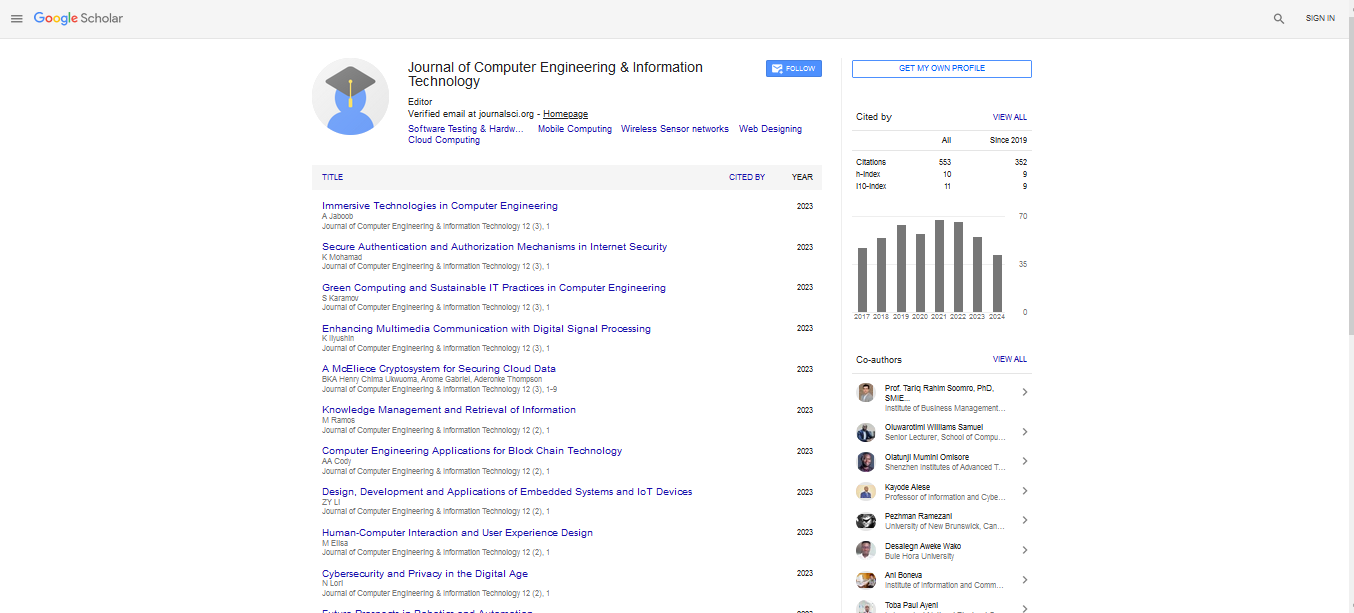Editorial, J Comput Eng Inf Technol S Vol: 0 Issue: 1
Current Trends in Applications for Software/Hardware Integration
| McDonald1*, Andel2, Mahoney3 and Russ4 | |
| 1Professor of Computer Science, School of Computing, University of South Alabama, USA | |
| 2Professor of Computer Science, School of Computing, University of South Alabama, USA | |
| 3Associate Professor of Information Assurance, Acting Director, School of Interdisciplinary Informatics, University of Nebraska at Omaha, USA | |
| 4Associate Professor and Interim Department Chair of Computer Engineering, College of Engineering, University of South Alabama, USA | |
| Corresponding author : J Todd McDonald Professor of Computer Science, University of South Alabama, USA Tel: (251) 460-7555 Fax: (251) 460-7274 E-mail: jtmcdonald@southalabama.edu, tandel@southalabama.edu |
|
| Received: August 10, 2015 Accepted: August 12, 2015 Published: January 19, 2016 | |
| Citation: McDonald JT, Andel TR, Mahoney WR, Russ SH (2016) Current Trends in Applications for Software/Hardware Integration. J Comput Eng Inf Technol. S1. doi:10.4172/2324-9307.S1-e101 |
Abstract
Current Trends in Applications for Software/Hardware Integration
In today’s modern computing world, software and hardware work together to produce the wide range of advanced system functions that support industry, science, and commerce.
| In today’s modern computing world, software and hardware work together to produce the wide range of advanced system functions that support industry, science, and commerce. Historically, software and hardware have been seen to be distinct entities with clear boundary lines, depicted in Figure 1. Traditional software consists of code in the form of high-level programming language commands or lowlevel assembly instructions, targeted specifically at a general purpose processor. Traditional hardware has evolved in the form of general central processing units (CPUs) and microprocessor chip families such as Intel and Motorola consistent with the original vision of the von Neumann architecture. In its historic use, compilers and interpreters that guaranteed compliance with underlying architecture guaranteed software/hardware integration. General purpose processor (GPP) architecture and code have thus formed the bulk of our modern application base. | |
| Figure 1: Traditional Notion of Software/Hardware Integration. | |
| The notion of software/hardware integration in modern parlance often alludes to the realm of embedded systems where microprocessor design crosscuts between physical hardware and operating system software that manages it. Cyber physical systems (CPS) extend this notion further to encompass systems that have real-time collaborating computational elements that control or are informed by physical devices and sensors [1]. At a higher level, software/hardware integration might involve the collaborative effect of networking appliances (the hardware) with the underlying control applications (the software) that must work together to produce client-server and multi-tier infrastructure. At a lower level, software/ hardware integration can involve system-on-chip (SoC) devices that allow high configurability of both reprogrammable logic and functionality, where devices like field-programmable gate arrays (FPGAs) constitute the hardware and logic programs constitute the software [2-5]. | |
| As Figure 2 illustrates, advancements in hardware technology have produced a revolution in computing power by offering task-specific processing components that can be leveraged by some underlying piece of software. For example, graphics cards and graphics processing units (GPUs) are nothing more than a specialized hardware for multimedia display and there are always associated software libraries that must be used in order to take advantage of the specific hardware features offered. Application specific integrated circuits (ASICs) have also become standard systems building blocks that provide specific functions leveraged by other hardware and software in a systems design. In many cases, physical hardware in the form of either ASICs or FPGAs can replace a slower software/GPP based solution as in the case of cryptographic ciphers like RSA and AES or with network security monitors [6]. FPGAs themselves can contain software-based or virtual processors, allowing agile configuration of the same piece of hardware to have almost unlimited programmability. With the advent of reprogrammable and specialized device technology, the line between software and hardware itself has become blurred [7]. | |
| Figure 2: Modern Notion of Software/Hardware Integration. | |
| This special issue on current trends in applications for software/ hardware integration highlights recent advancements, novel usage, and future concepts for how applications are constructed to realize the full extent of integration between these two worlds. For example, software applications that utilize specialized processors through custom or proprietary libraries already embody this concept. Likewise, software that utilizes FPGA-based logic functions to improve performance of otherwise time-intensive GPP code is in essence married to the hardware at a deeper level than a traditional GPP [8]. Without the underlying hardware present, the software would not function correctly or would not perform at its most efficient speed. | |
| The issue will look at advancements in tools, techniques, frameworks [9], methods, and practice for the prototyping, co-design, test, and verification of software/hardware integrated applications. Applications of full SW/HW integration can offer potential benefits to performance [10-13], security, agility, and configurability while also creating more complicated development and design issues. The special issue will also highlight advancements in languages [14,15], development environments, and industry support for this new paradigm of computing. Of particular interest are case studies of both successful and failed approaches, delineation of problems and issues [16], and potential solutions for SW/HW integrated applications. | |
References |
|
|
|
 Spanish
Spanish  Chinese
Chinese  Russian
Russian  German
German  French
French  Japanese
Japanese  Portuguese
Portuguese  Hindi
Hindi 